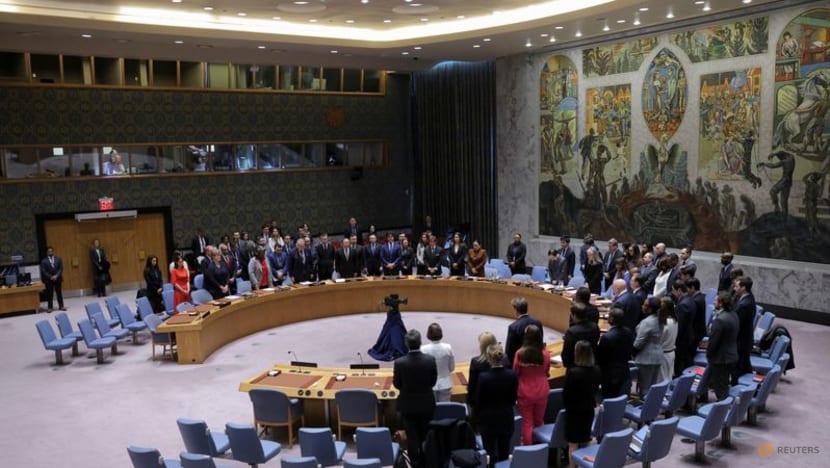CNA Explains: UN Security Council – the good, bad and ugly
The United Nations organ passed a resolution for the first time since the latest round of the Israel-Hamas conflict broke out in October. CNA's Liling Tan, who covered the UN for a decade, looks at what might happen next.

Members of the United Nations Security Council on the day of a vote on a Gaza resolution that demands an immediate ceasefire for the month of Ramadan leading to a permanent sustainable ceasefire, and the immediate and unconditional release of all hostages, at UN headquarters in New York City, US, Mar 25, 2024. (Photo: Reuters/Andrew Kelly)

This audio is generated by an AI tool.
SINGAPORE: Diplomacy marked a small win this week in the Israel-Hamas war that’s nearing its half-year mark.
The United Nations Security Council on Monday (Mar 25) passed a resolution demanding an immediate ceasefire in Gaza for the fasting month of Ramadan that ends in the second week of April.
It also demands the release of hostages from an Oct 7 Hamas attack on Israel, but stops short of stipulating this as a condition for a pause in fighting.
The resolution is a compromise in a Council deadlocked for more than five months, stymied from within its own ranks.
What does the Council do?
Tasked with maintaining peace and security around the world, the Security Council is the only organ of the UN with the authority to impose legally binding resolutions.
These can involve punitive measures like sanctions and embargoes, or political and humanitarian interventions like peacekeeper deployments and aid deliveries.
That authority is concentrated in a group of 15 members, 10 of whom are elected to serve two-year terms.
The other five hold permanent seats with a very special privilege: The power of the veto, in perpetuity.
A single veto can stop a resolution in its tracks. It is global diplomacy’s cancel culture, if you will.
Which countries have veto power?
The United States, the United Kingdom, Russia, France and China.
They are the allied victors of World War II, fiercely protective of a privilege reserved for them that dates back to the 1945 founding of the UN.
The good
The veto was conceived as a means of checks and balances, and a way to keep bad decisions from being passed.
It can prevent unnecessary military intervention, deter unfair economic sanctions and safeguard against outsized power wielded by any single nation.
The bad
But countries have been accused of using the veto to defend national interests; torpedo resolutions over conflicts they themselves were party to; and protect allies from international condemnation.
Critics argue that vetoes – and the threat of their use – can make or break conflicts and incapacitate the very UN body in charge of diffusing them.
The ugly
The most glaring example is the Security Council’s paralysis over the Russia-Ukraine war, given Moscow’s permanent veto-wielding membership.
Since the Council cannot move on the issue, the larger UN body known as the General Assembly has served as the main platform for nations to oppose Russia’s February 2022 invasion of Ukraine.
But resolutions there carry no legal weight.
There’s also the ongoing Syrian civil war that has divided permanent Council members, with Russia and China in one camp and France, the UK and the US in the other. It's led to a spike in the use of the veto.
The 13-year-old crisis continues to this day despite numerous Council emergency meetings, draft resolutions and dramatic walkouts.
In the case of the latest Israel-Hamas conflict, the broader Israeli-Palestinian conflict is nearly as old as the UN itself. But a two-state solution backed by almost every UN member nation remains far out of reach.
What's different about the latest resolution?
The Monday passage of the Gaza resolution is a paradigm shift made remarkable less by the vote of 14 out of 15 members, than by America’s notable abstention.
By not vetoing this resolution like it did for the last three, Washington let it go through, albeit without full endorsement.
And in doing so, it has distanced itself from Israel over the Gaza issue and deviated from near-blanket support of an ally that has largely stood the test of time.
Records show that in the past five decades or so, the US vetoed at least 50 Security Council resolutions on Israel, ranging from illegal settlements in the occupied territories to violence against Palestinians.
The divergence this week amplifies growing dissonance between the Biden and Netanyahu administrations over the latter’s handling of the conflict and the escalating humanitarian cost.
What happens now?
The question is if the US pivot will have any impact on a conflict that’s killed more than 30,000 people in under six months.
At the very least, a ceasefire could pave the way for more effective aid deliveries and save lives in and around the Gaza Strip over the next two weeks.
But it would also be just one ceasefire amid a sprawling, manifold battle with roots that go back decades.
In the context of the wider, protracted Israeli-Palestinian conflict, it could be seen as applying a band-aid to a gunshot wound.
















